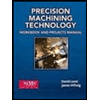go wrong with the job has gone wrong. (a) Determine the rate of metal removal when the wheel is engaged in the work. (b) If the number of active grits per cm? = 30, determine the average chip length and the number of chips formed per time. (c) What changes would you recommend in the grinding wheel to help solve the problems encountered? Explain why you made each recommendation.
go wrong with the job has gone wrong. (a) Determine the rate of metal removal when the wheel is engaged in the work. (b) If the number of active grits per cm? = 30, determine the average chip length and the number of chips formed per time. (c) What changes would you recommend in the grinding wheel to help solve the problems encountered? Explain why you made each recommendation.
Precision Machining Technology (MindTap Course List)
2nd Edition
ISBN:9781285444543
Author:Peter J. Hoffman, Eric S. Hopewell, Brian Janes
Publisher:Peter J. Hoffman, Eric S. Hopewell, Brian Janes
Chapter7: Grinding
Section7.3: Surface Grinding Operations
Problem 8RQ: Depth-of-cut range for surface grinding is: a. 0.010"0.100" b. 0.0001"0.0002" c. 0.0001"0.003" d....
Related questions
Question

Transcribed Image Text:In a surface grinding operation performed on a 6150 steel workpart (annealed,
approximately 200 BHN), the designation on the grinding wheel is C-24-D-5-V.
Wheel diameter =178 mm and its width= 25 mm. Rotational speed = 3000 rev/min.
Infeed = 0.05 mm per pass, crossfeed = 12.5 mm, and workpiece speed = 6 m/min.
This operation has been a source of trouble right from the beginning. The surface
finish is not as good as the 0.4 µm specified on the part print, and there are signs of
metallurgical damage on the surface. In addition, the wheel seems to become
clogged almost as soon as the operation begins. In short, nearly everything that can
go wrong with the job has gone wrong. (a) Determine the rate of metal removal
when the wheel is engaged in the work. (b) If the number of active grits per cm? =
30, determine the average chip length and the number of chips formed per time. (c)
What changes would you recommend in the grinding wheel to help solve the
problems encountered? Explain why you made each recommendation.
Expert Solution
This question has been solved!
Explore an expertly crafted, step-by-step solution for a thorough understanding of key concepts.
Step by step
Solved in 4 steps

Knowledge Booster
Learn more about
Need a deep-dive on the concept behind this application? Look no further. Learn more about this topic, mechanical-engineering and related others by exploring similar questions and additional content below.Recommended textbooks for you

Precision Machining Technology (MindTap Course Li…
Mechanical Engineering
ISBN:
9781285444543
Author:
Peter J. Hoffman, Eric S. Hopewell, Brian Janes
Publisher:
Cengage Learning

Precision Machining Technology (MindTap Course Li…
Mechanical Engineering
ISBN:
9781285444543
Author:
Peter J. Hoffman, Eric S. Hopewell, Brian Janes
Publisher:
Cengage Learning